|
|
|
|
|
English
|
Japanese
|
Chinese
|
Sanskrit / Pali
|
Korean
|
Tibetan
|
|
Historical Buddha, Founder of Buddhism, Sage of Shakya Clan, Enlightened One, Father of Buddhism, Gautama 喬答摩
|
Shaka 釈迦 or 釋迦
Shittatta 悉達多
Shakamon 釈迦文
Shakamon 釋伽文
Shakamoni 釋迦文尼
Shakamuni 釈迦牟尼
Kudon 瞿曇 (Gtm)
Shakamuni Butsu
釋迦牟尼佛
|
Shijia, Shìjiā
Shih-chia
Shih-cha-mo-ni
Shìjiāmóuní
Shìjiāmóuní fó
Shìjiā Rúlái
釋迦如來
|
Sakyamuni, Shakyamuni, Śākyamuni, Śākya-munis tathāgataḥ, Siddhartha, Siddhārtha, Siddhattha (Pali)
Gautama, Gotama (Pali)
Sākiya (Pali)
|
Seokga
Sŏkga
석가
|
Sha kya tu pa, Śā-kya t'ub-pa, Don-grub Gaú-ta-ma
|
|
|
|

Shaka Nyorai, Wood, Kamakura Era
Gokurakuji Temple, Right hand in “Fear Not” Mudra. Left hand in Blessing
Mudra. See Mudra for details. For a
list of Shaka’s teachings, click here.
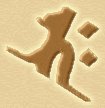
Shaka’s Sanskrit Seed Syllable
Baku (Japanese Pronunciation)
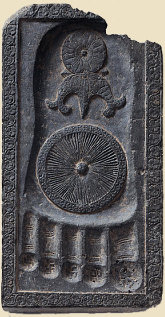
Footprint of Buddha, Pakistan
2nd - 3rd centuries A.D.
Photo courtesy:
miho.or.jp/english/
|
This Buddha footprint (from the Archaeological Museum, Swat, Pakistan) is thought to be the one mentioned in the travel records of the Chinese monks Faxien and Xuanzang, who made their pilgrimages in the 5th and 7th centuries respectively. Such footprints typically show the Swastika symbol on each toe.
Click here for details.
|
|
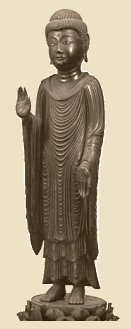
Kamakura Period
Photo Nara National Museum; Right hand in “Fear Not” Mudra; left in Blessing Mudra
|
|
 HISTORICAL BUDDHA HISTORICAL BUDDHA

Shaka Nyorai, Enlightened One
Shaka, Shakyamuni, Sakyamuni
Gautama Buddha, Prince Siddhartha
Founder of Buddhism
CLICK HERE FOR
GUIDE TO BUDDHA’S TEACHINGS
SHAKA NYORAI (BUDDHA) AND THE ORIGINS OF BUDDHISM
Buddhism originated in Northern India, or present-day Nepal. It was here that the Historical Buddha (aka Prince Siddhartha, Gautama Buddha), was born and lived in the sixth century BC. In China, his contemporaries were Confucius and Lao-tzu (the founder and “old boy” of Chinese Taoism), and slightly later in the West comes Plato (approx. 427 - 347 BC). When Buddhism arrived in Japan in the 6th and 7th centuries AD via Korea and China, Siddhartha became known in Japan as Shaka or Shakamuni, which means “Sage of the Shaka Clan” (his actual birth clan). In Japan, Shaka Nyorai (translated as Shaka Tathagata or Shaka Buddha) is venerated widely among most Buddhist sects, with the exceptions of the Jōdo Shinshū 浄土真宗 Sect (New Pure Land Sect, which revers Amida Nyorai) and the Shingon school of Esoteric Buddhism (which revers Dainichi Nyorai). Nonetheless, Shaka is honored as one of the 13 Deities 十三仏 (Jūsanbutsu) of the Shingon Sect. In this role, Shaka presides over the memorial service held on the 14th day following one's death.

Mantra for Shaka Nyorai = naamaku saamanda bodananbaku
EARLY BUDDHIST ART
For four centuries after Gautama’s death, legends and facts about the historical Buddha, his dialogues and his sayings, were preserved only in the memories of monks and followers. There were no written records or artistic representations. Like the Hindu Brahmins, the early Buddhists believed that religious knowledge was too sacred to be written down, too sacred to be etched in stone or wood. In those early years, when overt representations of the Buddha image were taboo, the main artistic vehicle for symbolizing the Buddha’s presence was to show the Buddha's “footprint.” These footprints of early Buddhist artwork can be found throughout Asia, often in narrative reliefs depicting key episodes in the Buddha's life, and thereby indicating his personal presence.
These footprints are often engraved with various Buddhist symbols (Click here for many more details about this topic). One of the most frequently used symbols in early Buddhism was the Svastikah 卍 -- which many centuries later is unfortunately misappropriated by Nazi Germany.
  卍. A symbol originating in India (Skt. Svastikah, Jp. Kyōji 胸字). Means “to be fortunate.” The word stem SVASTI can be divided into SU (SV), meaning good or well, and ASTI (ASTIKAH), meaning is or being. In modern India, the word means auspicious. In Japan it is used as a symbol of Buddhist faith, one found frequently on statues of the Buddha (Nyorai) and Bodhisattva (Bosatsu), and one of the 32 Marks of the Buddha (Sanjūnisō 三十二相). It represents the ”possession of all virtues” in Japanese Buddhism. See Footprints of Buddha for more. 卍. A symbol originating in India (Skt. Svastikah, Jp. Kyōji 胸字). Means “to be fortunate.” The word stem SVASTI can be divided into SU (SV), meaning good or well, and ASTI (ASTIKAH), meaning is or being. In modern India, the word means auspicious. In Japan it is used as a symbol of Buddhist faith, one found frequently on statues of the Buddha (Nyorai) and Bodhisattva (Bosatsu), and one of the 32 Marks of the Buddha (Sanjūnisō 三十二相). It represents the ”possession of all virtues” in Japanese Buddhism. See Footprints of Buddha for more.
Identifying Shaka Sculptures. Statues of Shaka Nyorai and other Nyorai (Buddha) share common attributes. These include elongated ears (all-hearing), a bump atop the head (Skt. usnisa, all-knowing, bump of knowledge), and a boss in the forehead (Skt. urna, third eye, all-seeing).
Among the many sculptural depictions of the various Nyorai (Buddha), some rules of thumb can help you to identify the historical Buddha. First, the Shaka Nyorai nearly always wears a simple monk’s robe, and is seated or standing on a lotus flower. This isn’t enough to identify the statue as Shaka, however, as the same guideline applies to most Nyorai (those who have attained Buddhahood). The Nyorai are typically portrayed wearing simple clothing, without accessories, jewelry, or weapons.
A second way to identify Nyorai statues is to look at the positioning of the hands. Two of the most common hand gestures (mudra) of Shaka Nyorai are the “Fear Not” Mudra (right hand held up) and “Blessing Mudra” (left hand pointing downward). Another common mudra portrays Shaka Nyorai with his left palm up and fingers outstretched (except the middle two, which may be curled in slightly to beckon people toward salvation), while the right hand is often, although not always, shown with the thumb held between the other four fingers (holding tightly to those who seek salvation).
A knowledge of these hand gestures -- called “mudra” in Sanskrit -- can help you identify and distinguish among the various Nyorai. The five most widely known mudras, moreover, correspond to five defining episodes in the life of the Historical Buddha. Nonetheless, mudra traditions vary greatly, and often it is impossible to identify statues based on mudra alone.

|
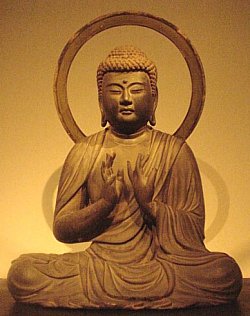
|
|
Kamakura Era
Gokuraku-ji Treasure
Life-size Wooden
Statue of Shaka
|
|
 Jō-roku 丈六, or “one jō and six shaku Jō-roku 丈六, or “one jō and six shaku
Jō-roku (or joroku) is equivalent to roughly 4.8 meters. Many “standing” sculptures in the early years of Japanese Buddhism are made to this specification. Jo is a unit of length, about three meters, and Roku means “six,” and this refers to six shaku (shaku is another Japanese unit of length, about 0.30 meters). Thus, Jo-roku is equivalent to roughly 4.8 meters. According to some Japanese legends, the Historical Buddha was actually that tall.
Historical Notes
In mainland Asia, less so in Japan, the Shaka Nyorai is pictured seated on a lotus with four petals, representing the four great countries of Asia (India, China, Central Asia, and Iran) during the early centuries of Buddhism’s introduction. The lotus is a symbol of purity. Although a beautiful flower, the lotus grows out of the mud at the bottom of a pond. The Buddha is an enlightened being who "grew" out of the "mud" of the material world. Like the lotus, the Buddha is beautiful and pure even though he existed in the material world.
Buddhism developed in India in the sixth century BC and gradually spread throughout Asia. However, it wasn’t until the Asuka Period (522-645 AD) that Buddhism arrived in Japan via Korea and China. Most of Japan’s earliest Buddhist sculpture and artwork were imported from mainland Asia, or made by Chinese and Korean artisans living in Japan. These old sculptures look almost exactly the same as their Chinese and Korean counterparts -- one defining characteristic of these early sculptures is the “skinniness” or non-human-ness of the statues (see two photos below of Shaka Trinity).
 |
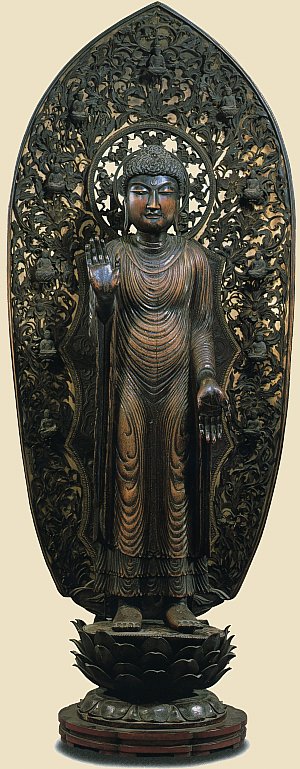 |
Seiryōji Shaka (Seiryoji Shaka), 987 AD
Wood, Height = 162.67 cm
Yosegi Zukuri Carving 寄木造 (Assembled Wood)
Kirikane 截金 Decorative Technique (see note below)
Treasure of Seiryouji Temple 清凉寺 (Kyoto)
Photo Courtesy: National Treasures of Japan 日本の国宝
Magazine, Published 8 July 1997 by The Asahi Shimbun
Says JAANUS About Seiryōjishiki Shaka 清凉寺式釈迦
Abbreviation of Seiryōjishiki Shaka Nyoraizō 清凉寺式釈迦如来像, also known as Zuizō Shaka 瑞像釈迦. A sculpture of Shaka modeled after the Shaka image Shakazō 釈迦像 at Seiryōji Temple 清凉寺 (popularly known as Saga Shakadō 嵯峨釈迦堂) in Kyoto. The Seiryōji image itself was brought from Northern Song China to Japan by the Tōdaiji 東大寺 priest Chōnen 奝然 in 987 AD. Copies of this image were made for temples all over Japan. Seiryōjishiki Shaka is a generic term for all such images. <end JAANUS quote>
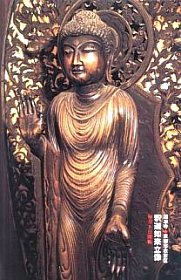 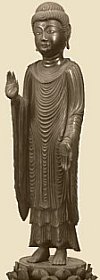 
Seiryōjishiki Shaka 清凉寺式釈迦
Left = Original statue brought from China to Japan in 987 AD
Middle & Right = Copies made in Kamakura period
LEGEND ABOUT SEIRYOUJI STATUE. According to texts brought from India to China in the 5th and 7th centuries, Mahayana traditions claim that two statues were made of the Historical Buddha soon after his death. The statues were supposedly commissioned by Prasenajit and Udayana, two Indian kings who were Buddha’s faithful disciples. One was made in gold, the other of red sandalwood. The second image, based on the legend, was carried off to China in the early 5th century, and then, in later centuries, it was stolen by a visiting Japanese monk who replaced the original with a clever copy. Seiryouji Temple 清凉寺 in Kyoto claims to be the owner of this statue, which it says provided the model by which all other statues of the Historical Buddha (Shaka) were modeled. This legend has been debunked, however, for the Seiryouji Shaka image has been clearly dated to 987 AD. <Source: Flammarion Guide to Buddhism, as well as many other English and Japanese publications>
LEGEND ABOUT “UDAYANA” STATUE
According to Indian legend, the first two Buddha sculptures in the world were made from Indian sandalwood and “purple gold” (a gold of the highest quality, which gives off a purple sheen). Once, it is said, Sakyamuni Buddha left this world to deliver a sermon to his mother, who resided in the Trayastrimsa Heaven. During the Buddha’s absence, King Udayana began yearning for him, and so made a sandalwood statue of his beloved teacher. This sculpture was widely known among Buddhist followers as the Udayana Sandalwood Sakyamuni and was the object of great admiration. This Buddha figure was later transported to Quici (now Kuche), then was moved again in the year 401 AD to the Chinese city of Chang’an (current day Xian), where many copies were made. With the arrival of this sculpture, sandalwood images came to be quite widely produced even within China and many records of the production of such Buddhist sculptures survive from the second half of the 5th century. <Source: Exhibition Catalog entitled “Shaping Faith: Japanese Ichiboku Buddhist Statues;” Published 2006 by the Tokyo National Museum and Yomiuri Shimbun>
Note About Kirikane (Kirigane) 切金. Also written 截金. Literally "cut gold." A decorative technique used in Buddhist artwork to adorn Buddhist statues. The technique came from Tang China, arriving in Japan sometime in the 7th century. Leaves/sheets (haku 箔) of gold or silver (sometimes other metals) are pressed together, cut into long thin strips or other shapes, then affixed to the surface of a statue or painting. A related term is kirihaku 切箔, which refers to a decorative metal pattern on sculptures or paintings. Kirikane was a popular technique in the Heian period for sculpture and painting. But it fell into decline during the Kamakura period, replaced by the use of gold paint (kindei 金泥) for creating the decorative gold outlines and patterns. Kirikane also refers to a decorative method popular in the Kamakura period for adorning lacquer statues with cut metal. For more techniques on making statues, see the Materials and Techniques Glossary for Making Buddhist Statuary.
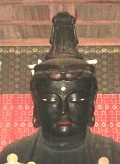 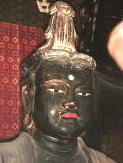
Black Shaka Nyorai with Headdress
Jufuku-ji -- Zen Temple in Kamakura
This is unusual, as Shaka statues are typically unadorned
Statues of the Nyorai are not typically shown with accessories (e.g. crown, jewelry). But in some Zen temples (such as Jufukuji and Kenchoji and Shuzenji in Kamakura), Nyorai statues wear a crown atop the head. Zen Buddhism worships the Historical Buddha as well as the Birushana Nyorai -- the latter is often portrayed with a crown, and the Historical Buddha is sometimes shown as a manifestation of Birushana. Not sure why it is black though. Since Zen worships the Kegon-kyo (Garland Sutra), the answer may lie there.

Why are there so many Buddhas ?
|
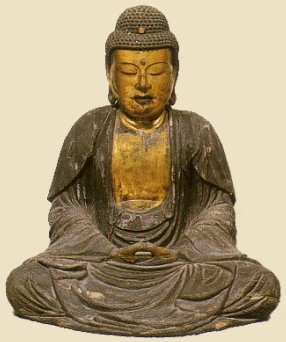
Shaka Nyorai
Hase Dera, Kamakura, Date Unknown
|
|
The teachings of the historical Buddha are generally known as Theravada Buddhism and are based on the original teachings of Gautama Siddhartha. He believed that all life was suffering, and that suffering was caused by desire. He sought, through meditation, to attain a state known as Nirvana, in which he would be free of desire and therefore suffering.
The form of Buddhism that came to Japan in the Asuka Period, however, was known as Mahayana Buddhism. Unlike the Theravada school, which was limited to a small “select” group of followers who sacrificed all to pursue its harsh monastic regimen as monks, the Mahayana school aimed to bring salvation to the common people. In Mahayana Buddhism -- unlike Theravada -- each and every living person can attain Buddhahood, not just the monastic community. To Mahayana practitioners, many people have achieved enlightenment over countless ages, and the Historical Buddha (i.e.Shaka Nyorai) is just one of many enlightened beings. Thus numerous Buddha and Bodhisattva populate the Mahayana pantheon. For a discussion of the difference between Theravada and Mahayana Buddhism, please click here.

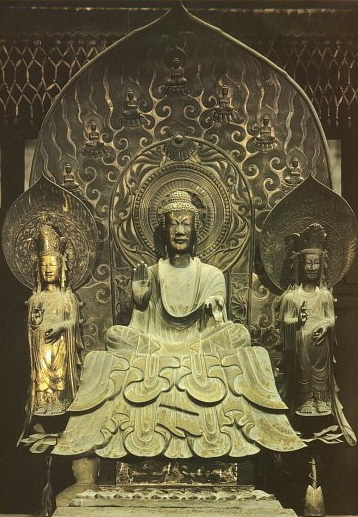
Famous bronze Shaka Trinity, 632 AD
Height = 86.4 cm, Hōryūji Temple 法隆寺 in Nara
Surrounded by two attendants (thought to be Yaku-ō Bosatsu & Yakujō Bosatsu).
Early Buddhist images have elongated faces & hands. See Early Japanese Statuary.
Learn more about Buddhist statuary in 7th-century Japan.
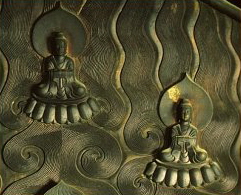
Closeup of above photo’s background frame

|
QUICK GUIDE
Life & Teachings of the Historical Buddha
In China, his contemporaries were Confucius (551-479) and Lao-tzu (the founder and “old boy” of Chinese Taoism) -- only slightly later in the West comes Plato (427? - 347 BC).
Birth (561? to approx. 483 BC) --------------------------
Like Mary’s immaculate conception of Jesus Christ, the birth of the Historical Buddha was not ordinary. According to legend, the Buddha’s mother (Lady Māyā, aka Mahāmāyā or Māyādevī) dreamt of a divine being atop a white elephant descending from heaven, touching her side, and entering her womb. The elephant imagery indicates that her child came from the pure land known as Tuṣita, home of Bodhisattva Maitreya (Jp. = Miroku). The child was born near Kapilavatthu (in current-day Nepal), emerging from his mother's side, which emitted a seven-colored light that brought forth the infant, who then took seven steps forward while pointing his right hand to the heavens and left hand to earth (see image here), saying: "I alone am honored in heaven and on earth (tenjō tenga yuiga dokuson 天上天下唯我独尊)." Statues depicting the infant in this pose are used in the Kanbutsu-e 潅仏会 ceremony, held annually in Japan on April 8, to commemorate Buddha's birthday. The child was named Siddhartha, and since his father's surname was Gautama, he was called Gautama Siddhartha. His mother died seven days after giving birth. There is some disagreement among scholars as to the actual dates of his birth and death. Recent scholarship suggests that Gautama (Pali = Gotama) did not leave his home to seek enlightenment until 450 BC. See Heinz Berchant, “The Date of the Buddha Reconsidered,” Indologia Taurinensin, 10.
Early Life -------------------------
At his father's urging, Siddhartha married princess Yasodhara, who bore him a son named Rahula. Despite a life of ease -- his father provided him with three palaces, one each for the rainy season, the dry season, and the winter -- Siddhartha left his royal estates when he was only 29 years old. Prior to leaving, he showed unusual sensitivity and concern for the problems of human existance. During his trips outside the palace walls, he witnessed and contemplated the fundamental human sufferings of aging, sickness, and death. He also witnessed an ascetic who seemed oblivious to suffering, and from this sprang Siddhartha's quest to leave the palace, withdraw from the world, and search for truth as an ascetic.
|
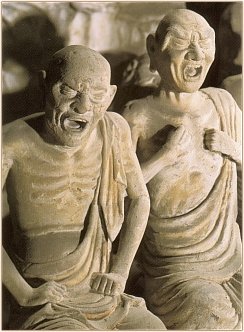
Ascetics Near Starvation
Hōryūji Temple 法隆寺 in Nara, 711 AD
North Side, Tohonshimengu
|
|
Ascetic Life ---------
For six years Siddhartha practiced severe austerities -- one legend says he ate only a single grain of rice a day, while others say he ate only a single sesame seed each day. Many artistic representations of Siddhartha's ascetic years show him wasted to skin and bones. But he came to realize that self-mortification (and its opposite, the life of ease and indulgence) was not the answer. The answer, in his mind, was the Middle Way. So he ended his days as an ascetic, came down from the mountains to cleanse himself in the Nairanjana River, and then sat under a bodhi (bo) tree to meditate. For seven days he meditated, during which time he was attacked and tempted by evil spirits who hoped to break his meditation. On the seventh day, at the age of 35, Siddhartha attained Buddhahood. In Japan, December 8th is celebrated as the day of Siddhartha's enlightment.

Bodhi (Bo) Tree | 菩提樹 | ぼだいじゅ
Originally called the "pippala" tree in ancient India, and believed to possess spiritual powers; the Historical Buddha awoke to enlightenment while sitting under the tree, so it has since been called the Bodhi tree. The Sanskrit “Bodhi” means enlightenment, and in Japan, the term was tranliterated as “Bodai.” In Japan, the term “Bodai” is synonymous with “satori” -- both terms mean enlightenment.
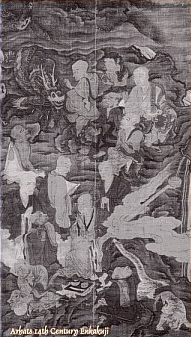  The Teacher and His Disciples The Teacher and His Disciples
Legend contends that the Lord Buddha or Sakyamuni in Sanskrit (he is no longer called Siddhartha after reaching Buddhahood) decided to keep his achievement and teachings to himself, for others would not believe or comprehend. But his mind was changed by the appearance before him of Brahman (the chief Hindu god; Jp. = Bonten), who urged him to preach what he had learned and help others along the same path. From that point on, until his death at age 80, the Buddha preached without interval. The Chinese transliterated Sakyamuni as Shìjiāmóuní, but this was later shortened to Shìjiā in China and Shaka in Japan. “Shaka” is another word for the Historical Buddha, for as a human, he was born into the Sakya (Shaka) clan, a tribe that ruled a small state that today is located in Tarai (Nepal) near the border with India.
His companion ascetics were the first to become his disciples, and soon afterwards they too attained enlightenment -- in Sanskrit they are known as the Arhan (Jp. = Arakan 阿羅漢), an Indian word meaning "one who is worthy of receiving obeisance." Arhatship is the main goal of all who practice Theravada Buddhism.

The most famous of the early disciples are called the Ten Great Disciples (Jūdai Deshi 十大弟子), and they play a major role in Buddhism’s early development.
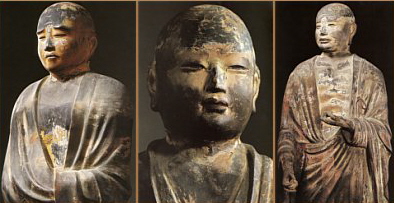
The Ten Great Disciples (Jūdai Deshi 十大弟子)
Above: 734AD, Kofukuji (L) Ragora (M) Subodai (R) Furuna
Below: 734AD, Kofukuji, (L) Kasen-en (M) Mokukenren (R) Sharihotsu
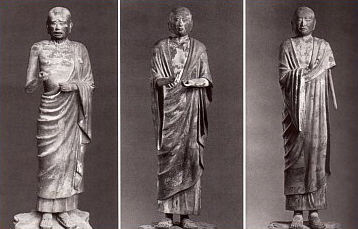

Death -------------------------
By tradition, the date of the Historical Buddha’s death is February 15. In Japan, a Buddhist service called Nehan'e 涅槃絵 is performed each year on this day. According to legend, the Buddha's death was attended by gods, celestial maidens, people, and animals -- even the plants gave homage. The story of the Buddha's last moments are recorded in great detail in the sutra known as The Sutra of the Great Extinction 大船涅槃経 (Daihatsu Nehan-gyō), in which the Buddha declares that he has taught all, withholding nothing, for he has no intention to exercise control by means of secret doctrines. Near his death he said: "Make the self your light, make the Law your light."
For a wonderful visual exploration of a hanging scroll (dated 1325 AD) showing the death of the Buddha, please click here (outside site). Numerous close-ups of the scroll are presented. The scroll is a treasure of Myōhōji Temple 妙法寺 (Hyogo Prefecture).
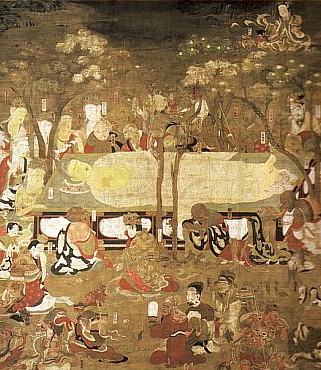
Death of Buddha, Painting dated to 1086 AD, Byōdōin Temple 平等院
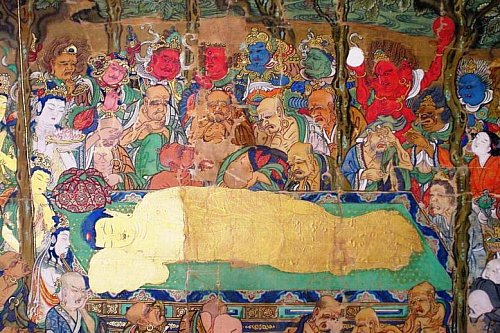
Closeup, Hanging Scroll, by Myōson 命尊, 1325 AD
Death of Buddha; Treausure of Myōhōji Temple 妙法寺
Click here from many more wonderful photos.

Essential Teachings -------------------------
In Buddhist philosophy, believers can themselves attain Buddhahood. This is significantly different from Christianity, Judaism and Islam. In the latter, believers cannot attain the same status as their god. They are encouraged to learn the teachings and become "godlike," but they do not strive to become gods themselves. This, however, is the main goal of Buddhist practice -- to attain Buddhahood through good works, right thinking, and right action.
Both modern-day Theravada Buddhism and Mahayana Buddhism are based largely on the same set of teachings (see below) from the Historical Buddha. For more on these two schools of Buddhism, please click here.
Seven Buddhas of the Past -- Kako Shichibutsu 過去七仏
Gautama Buddha is the last Buddha in the current Buddhist Era (World Cycle). The present era is called the Auspicious Aeon (Jp = Kengou 賢劫; Skt = Bhadra-kalpa). According to Buddhist lore, there are six Buddhas who came prior to Shaka Nyorai (Gautama Buddha), three from the prior era (Jp = Shougun 莊嚴) and three in the present era (Jp = Kengou 賢劫). This group of seven is collectively known as the Seven Buddhas of the Past (過去七仏).
Turning the Wheel of Dharma (Law)
By tradition, Gautama’s teachings are divided into three main categories, referred to as the First Turning of the Wheel of Dharma, the Second Turning, and the Third Turning.
- First Turning. At Deer Park, Sarnath, Gautama revealed the truth of suffering (Skt: Samsara) and liberation (Skt: Nirvana), known as the Four Noble Truths and the Eightfold Path; the basis of Theravada Buddhism (pejoratively known as Hinayana, the Lesser Vehicle).
- Second Turning. Teaches the truth of emptiness (Skt. Sunyata) and the doctrine of the Boddhisattvas - those who aspire to enlightenment by means of compassion (Skt: Karuna); the basis of Mahayana Buddhism (Greater Vehicle).
- Third Turning. Teachings of absolute and relative truths and the Tathagatagharba, the enlightenment nature inherent in all beings; the basis of Vajrayana Buddhism (Diamond Vehicle).

Tripitaka (Three Baskets) 三蔵 (律・経・論)
After the Historical Buddha's death, a great council gathered together his teachings into what is called the Tripitaka (The Three Baskets). But nothing was actually written down until a few centuries later:
- Vinaya, codes of conduct, mostly for monks and nuns
- Sutras, the discourses on meditation, although these were not written down until centuries later
- Abhidharma, logical and scientific commentaries on human perception written by followers over then next thousand years
Four Noble Truths 四諦 | したい | Shitai
- Life is suffering (苦諦 | くたい | Kutai)
- Suffering has cause (集諦 | じったい | Jittai)
- Eliminate cause and thereby eliminate suffering (滅諦 | めったい | Mettai)
- Learn and pursue the Eightfold Path (道諦 | どうたい | Dōtai)
Eightfold Path 八正道 | はっしょうどう | Hasshō-do
- Right View (正見 | しょうけん | Shōken)
- Right Resolve Right Thinking (正思惟 | しょうしゆい | Shōshiyui)
- Right Speech (正話 | しょうご | Shōgo)
- Right Action (正業 | しょうごう | Shōgō)
- Right Living or Right Occupation (正命 | しょうみょう | Shōmyō)
- Right Effort (正精進 | しょうしょうじん | Shōshōjin)
- Right Mindfulness or Right Memory (正念 | しょうねん | Shōnen)
- Right Concentration or Right Meditation (正定 | しょうじょう | Shōjyō)

Twelve Causes of Suffering
十二因縁 | じゅうにいんねん | Jūni In Nen
- Ignorance (無明 | むみょう | Mumyō), the fundamental cause of suffering
- Activity based on Ignorance (行 | ぎょう | Gyō)
- Mistaken conciousness based on actions arising from ignorance (識 | しき | Shiki)
- Objects of Consciousness (名色 | みょうしき | Myōshiki); both material objects and the organs of sense
- Six Entrances (六入 | ろくにゅう | Rokunyū); refers to the eye, ear, nose, tongue, body, and mind -- the six sense organs -- by which we encounter the objects of consciousness
- Contact with External Objects (触 | しょく | Shoku); refers to our reception of the objects of consciousness via our six entrances
- Sensation (受 | じゅ | Jyu); that which occurs from contact with external objects
- Desire for Pleasure and Hatred (愛 | あい | Ai); the human penchant for either desiring or detesting the object of sensation
- Clinging (取 | しゅ | Shu); positive or negative attachment to what one desires or detests
- State of Transmigration (有 | う | U); our level of attachment reflects our location within the "six realms of existence"
- Birth (生 | しょう | Shō); our rebirth within the six realms reflects cause and effect
- Old Age and Death (老死 | ろうし | Rōshi); the law of causation means that humans must grow old and die (we will experience suffering until we can overcome our ignorance -- the first of the Twelve Causes and the fundamental cause of suffering)

Take the Middle Path 中道 | ちゅうどう | Chū-dō
Enlightenment cannot be achieved by practicing either austerity or pleasure. The road to enlightenment is the middle path.
Four Sufferings and Eight Sufferings
Shiku 四苦 and Hakku 八苦
Gautama Buddha believed that all life was suffering, and that suffering was caused by desire. He sought, through meditation, to attain a state known as Nirvana, in which one is free of desire and therefore suffering. Suffering is caused by human weakness -- desire, lust, pride, anger, greed and a host of other foibles. The philosophical foundations of Buddhism proclaim that all worldly phenomena is unsatisfactory, transient and impermanent; there is nothing one can call one's own; the world is an illusion; and our suffering is caused by our clinging to the world of illusion (the world of desire). There are four basic sufferings, to which four more were added in later times:
- Birth
- Old Age
- Illness
- Death
- Parting from those one loves
- Having to meet those one hates
- Not being able to have what one desires
- Clinging to the five aggregates (sufferings of the mind and body)
Note: In Japanese, this grouping of four and eight gave rise to the Japanese expression Shiku Hakku, which means "agony and distress."
|

Major Episodes in Artwork of Shaka
Text courtesy of www.art-and-archaeology.com/india/glossary1.html
The life of Buddha began to be represented in art sometime before 100 AD. The major episodes are:
- Dream of Maya (conception)
- Birth
- Four Sights (of human suffering)
- Great Departure (leaving home)
- Temptation of Mara
- Enlightenment
- First Sermon
- Parinirvana (death of the Buddha)
Buddha was a contemporary of Mahavira, the founder of Jainism, and there are many intriguing parallels between the two religions.
Theravada Buddhism emphasized the difficulty of attaining salvation, and advocated meditation and the monastic life as the means to salvation for a chosen few. This view was challenged by the Mahayana ("Greater Vehicle") school, who proclaimed the existence of numerous Buddhas and Bodhisattvas as universal saviors. Buddhism died out in India around 1200 AD, succumbing to Muslim invasions as well as a resurgent Hinduism. However, by this time the religion had spread via the trade routes to east and southeast Asia, where it took root and has flourished up to the present day. <end quote>

Mythical Home of Shaka Nyorai
Mt. Shumisen (Mt. Sumeru, Mt. Meru) is the mythical home of Shakya Nyorai (the historical Buddha). According to Buddhist lore, Mt. Sumeru is located at the center of the world, surrounded by eight mountain ranges, and in the ocean between the 7th and 8th there are four continents inhabited by humans. These four continents are protected by the Shitenno, with each leading an army of supernatural creatures to keep the fighting demons (Ashura) at bay. On the top of Mt. Sumeru is the heavenly palace of Shakya Nyorai, and the abode of the Trayastrimsha (33 Gods) ruled by Taishakuten.

Transmigration of Souls & Reincarnation
The Six States of Existence
Buddhist teachings incorporate countless manifestations of Buddhas and Bodhisattvas. To Buddhists, the transmigration of souls from one creature to another has continued unabated for aeons. Those reaching full enlightenment are few, for the path to awakening is long and arduous. But the path is not closed, and in any period, one or more -- or none at all -- may appear. It is said that Gautama (Siddhartha, Shaka, the historical Buddha) did not attain enlightenment in one life time, but rather struggled over many lives and through numerous incarnations to finally become a Bodhi-being. In some Buddhist traditions, the term Bodhisattva actually refers to Guatama Buddha prior to his enlightenment -- including the countless lives he passed through en route to Buddhahood. These earlier lives are called the Jatakas (birth stories), and they are a very frequent subject of Buddhist lore and art.
There are six states of existence before one reaches Buddhahood. The lowest three states are called the three evil paths, or three bad states. They are (1) people in hells; (2) hungry ghosts; (3) animals. The highest three states are (4) Asuras; (5) Humans; (6) Devas. All beings in these six states are doomed to death and rebirth in a recurring cycle over countless ages -- unless they can break free from desire and attain enlightenment. Click here for Japanese spellings of the six states.

Kanbutsu-e 潅仏会
Ceremony to Commemorate Buddha’s Birthday
Text courtesy of www.aisf.or.jp/~jaanus/deta/k/kanbutsue.htm.
A ceremony held every year to commemorate Buddha's birthday, April 8th, where a small statue of Buddha is sprinkled with scented water or hydrangea tea. The ceremony recreates a legend that when the Buddha was born he was sprinkled with perfume by the dragon god (ryuuou 竜王). A small shrine, known as the hanamidou 花御堂 is set up and decorated with flowers. A small image of the Buddha in the form of a child as he appeared at birth (tanjoubutsu 誕生仏; see below), is placed on a wide, shallow metal bowl, known as the kanbutsu-ban 潅仏盤. The statue of Buddha has the right hand held up, and the left hand pointing down, depicting the moment when Buddha took seven steps forward and pronounced the words “Tenjou tenga yuiga dokuson 天上天下唯我独尊“ (I alone am honored in heaven and on earth). Visitors to the temple where the ceremony is performed use a small ladle to sprinkle scented water over the top of the statue. The kanbutsu-e ceremony was brought to Japan from China, and the first recorded celebration in Japan was at Gankouji 元興寺 in Nara in 606. It spread to become a regular part of Buddhist tradition in other temples, the court, and among ordinary citizens. A famous Kanbutsu-ban decorated with hunting scenes is preserved in Nara's Toudaiji 東大寺. It dates from the Nara Period and shows outstanding metal craftsmanship.

Tanjoubutsu 誕生仏 or Buddha’s Birth
Text courtesy of www.aisf.or.jp/~jaanus/deta/t/tanjoubutsu.htm.
Lit. Buddha at birth. A sculptural representation of the historical Buddha Shaka 釈迦 immediately after his birth. According to legend, his mother Mahamaya gave birth to him from her right side. The infant then took 7 steps and, pointing to the heavens with his right hand and to the earth with his left hand, proclaimed, "I alone am the honoured one in the heavens and on earth." The tanjoubutsu show the infant Shaka in this pose, usually wearing a loincloth. Shaka's birth is counted among eight major events in his life (Shaka Hassou 釈迦八相), but statuary representations of this type are rare outside of Korea and Japan. Elsewhere the infant Shaka is generally depicted in reliefs and murals with both arms hanging at his side or with the right hand raised in the “mudra bestowing fearlessness” (semui-in 施無畏印). In Japan images in bronze (and occasionally in wood) between 5-20 cm in height are very common because they have becomes a requisite for the kanbutsu-e 潅仏会 or “rite for sprinkling” (an image of) the Buddha. The rite is performed annually on the 8th day of the 4th month in celebration of Shaka's birthday, when a tanjoubutsu statuette is placed in a shallow bowl, kanbutsuban 潅仏盤 inside a small shrine decorated with flowers, hanamidou 花御堂 and is sprinkled by worshippers usually with sweet hydrangea tea, amacha 甘茶 in imitation of the 2 dragon-kings who are said to have poured perfumed water on Shaka when he was born. This rite, which may be traced back to the 7th c., is today more commonly known as hanamatsuri 花祭り or ”flower festival.” Tanjoubutsu date from as early as the Asuka period, but the most renowned is at Toudaiji 東大寺 (Nara; national treasure). Other representative examples include those at Goshinji 悟真寺, Nara (Hakuhou period ), Zensuiji 善水寺, Shiga prefecture (Nara period), and Daihouonji 大報恩寺, Kyoto (Kamakura period).

Shaka Hassou 釈迦八相
Text courtesy of www.aisf.or.jp/~jaanus/deta/s/shakahassou.htm
Lit. eight phases (or aspects) of Shakamuni 釈迦牟尼. Also referred to as hassou joudo 八相成道 ("eight-phase attainment of the path"), hassou jigen 八相示現 ( "manifestation of the eight phases"), or simply hassou 八相 ( "eight phases"). The eight major events in the life of the historical Buddha, Shakyamuni (Shaka 釈迦), that constitute a popular format for artistic representations of Shakamuni's life (butsuden-zu 仏伝図). The practice of selecting eight particular events in which to encapsulate the course of Shakamuni's career is thought to have been established in China. There are several traditions regarding the events constituting the "eight phases." Probably the most common one is derived from the SIKYOUGI 四教義 (Ch: Shjiaoyi; "The Meaning of the Four Teachings") by Zhiyi 智顗 (Jp :Chigi; 538-597). Its eight parts include:
- Goutosotsu 降兜率, descending from Tusita Heaven
- Takutai 託胎 (also nittai 入胎), entering his mother's womb
- Shusshou 出生 (also shuttai 出胎 ), birth
- Shukke 出家, renouncing the world to become a mendicant
- Gouma 降魔, subjugating demons
- Joudou 成道, enlightenment
- Tenbourin 転法輪, "turning the wheel of the law" or preaching the Dharma; tenbourin-in is the mudra for teaching the law.
- Nyuunehan 入涅槃 (also nyuumetsu 入滅), "entering nirvana" or death
In another tradition, based on the DACHENG QIXIN LUN 大乗起信論 (Jp: DAIJOUKISHONRON: "Treatise on the Awakening of Faith in the Great Vehicle"), (5) gouma is omitted and jutai 住胎 (abiding in his mother's womb) added after (2) takutai. The hassou joudo places the central importance in Shakamuni's life on his attainment of enlightenment (6). In Japan, sets of images of these "eight phases" are recorded as having been enshrined in, for example, the East and West Pagodas of Yakushiji 薬師寺 (Nara) although these particular examples are no longer extant. There are, however, many examples of paintings depicting these eight scenes: those depicting either Shakamuni's enlightenment or his death in the center, with the remaining seven events on the periphery, are known as Shaka hassou joudo-zu 釈迦八相成道図 ("painting of Shakamuni's eight-phase attainment of the path") and Shaka hassou nehan-zu 釈迦八相涅槃図 ("painting of Shakamuni's eight-phase nirvana"; see nehan-zu 涅槃図) respectively. A renowned example of the former is preserved at Daifukudenji 大福田寺 (Mie prefecture) and equally renowned examples of the latter are found at Manjuji 万寿寺 (Kyoto) and Tsurugi Jinja 剣神社 (Fukui prefecture). Didactic works such as the SHAKA HASSOUKI 釈迦八相記 ("Account of the Eight Phases of Shakamuni") and SHAKA HASSOU MONOGATARI 釈迦八相物語 ("Story of the Eight Phases of Sakyamuni"), aimed at the general populace, utilized these "eight phases" as a convenient device for teaching the salient points in the story of Shakamuni's life.

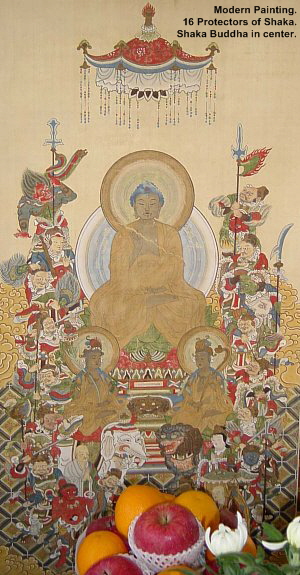  16 Good Gods 16 Good Gods
(Jūroku Zenjin, Juroku Zenjin 十六善神). Protectors of the Daihannyakyō Sutra 大般若経 (Great Widsom Sutra, Skt. Mahaprajna paramita sutra) and those devoted to it. But more accurately referred to as the 16 Protectors of Shaka Nyorai (the Historical Buddha), or Shaka Jūroku Zenshin 釈迦十六善神, or Shaka Sanzon Jūroku Zenshin 釈迦三尊十六善神. They are depicted as warlike figures (Yasha 夜叉), and paintings of the sixteen were invoked at the Daihannya-e 大般若会 ceremony. They often appear in the Sangatsu-kyō Mandala devoted to Shaka. In Japan, the 16 are also shown around Hannya Bosatsu 般若菩薩, who is sometimes invoked instead of Shaka during the Daihannya-e service, which involves the ritual reading of the 600-fascicle Hannyakyō 般若経 sutra (translated into Chinese by Xuanzang 玄奘 (Jp. = Genjō) in the 7th century AD.
- Daitorada 提頭羅宅; Jikokuten 持国天 (one of four Shitennō)
- Birurokusha 毘盧勒叉; Zōchōten 増長天 (one of four Shitennō)
- Saifukudokugai 摧伏毒害
- Zōyaku 増益
- Kanki 歓喜
- Joissaishōnan 除一切障難
- Batsujozaiku 抜除罪垢
- Nōnin 能忍
- Ueshiramanu 吠室羅摩拏; Tamonten 多聞天 (one of four Shitennō)
- Birubakusha 毘盧博叉; Kōmokuten 広目天 (one of four Shitennō)
- Riissaifui 離一切怖畏
- Kugoissai 救護一切
- Shōfukushoma 摂伏諸魔
- Nōkushō 能救諸有
- Shishiimō 師子威猛
- Yūmōshinchi 勇猛心地
Bonten 梵天 and Taishakuten 帝釈天 are also sometimes added, making eighteen. Paintings of the 16 Good Gods sometimes include other protective deities, including Changti 常啼 (Jp: Jōtei ), the nun Fayō 法優 (Jp: Hōyū), Basusen 婆薮仙, and Kudokuten 功徳天 (an emanation of Kichijōten 吉祥天, the goddess of fortune and merit). Paintings may also include Anan 阿難 and Kashō 迦葉, disciples of the Historical Buddha (Jūdai Deshi 十大弟子). In addition, Hannya Bosatsu is sometimes surrounded by the 16 Protectors.
Says JAANUS: “The Sixteen Protectors of Shaka are a specific group of warlike figures (yasha 夜叉) believed to be the protectors of the DAIHANNYAKYOU 大般若経. In art, Shaka, with the mudra of either tenbourin-in 転法輪印 or seppou-in 説法印, is attended by the two bodhisattvas Fugen 普賢 and Monju 文殊. The Sixteen Protectors appear in two groups of eight to either side and in front of the principal figures. They are believed to guard the sutra and those who uphold it. Paintings of the Sixteen Protectors were hung as central images for ceremonies called Daihannya-e 大般若会 at which there was a tendoku 転読 (flipping through pages, or opening scrolls, and reading the chapter headings at breakneck speed) of the text a certain number of times. The earliest record of commissioning a painting for a ceremony dates from 1114, while the earliest extant paintings date from the third quarter of the 12th century. <end JAANUS quote>

LEARN MORE
- Buddhist-Artwork.com. Statues of Shaka Nyorai are available at this online store, which launched in July 2006. The estore (our sister site) offers quality hand-carved wooden statues of many Buddhist deities, especially those carved for the Japanese market. Aimed at art lovers, Buddhist practitioners, and laity alike, the estore is not associated with any educational institution, private corporation, governmental agency, or religious group.

Our sister site

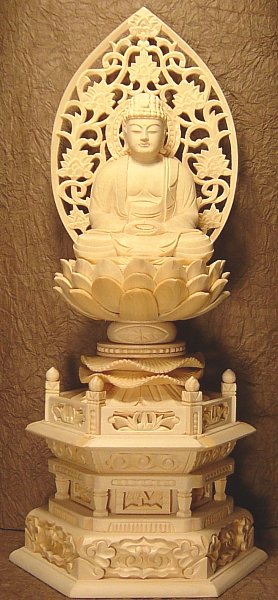
Shaka Nyora, the Historical Buddha
Modern: This & others statues available for online purchase

|
|